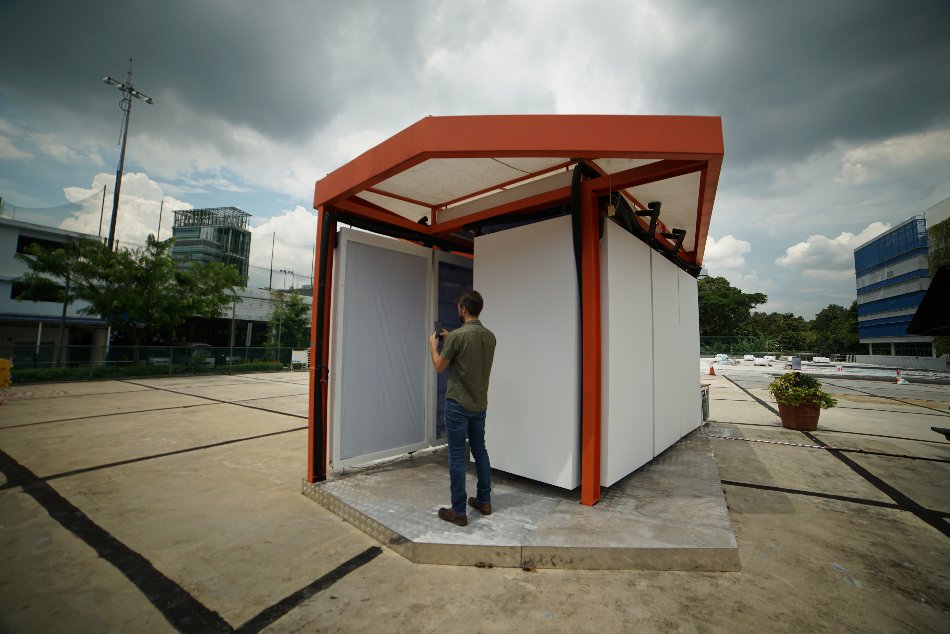Aug 19 2020
A majority of the people turn to air conditioning to beat the summer heat. But air conditioners tend to consume excess power and release millions of tons of carbon dioxide every day.
 Exterior of Cold Tube demonstration pavilion. Image Credit: Lea Ruefenacht.
Exterior of Cold Tube demonstration pavilion. Image Credit: Lea Ruefenacht.
Moreover, air conditioners are not always good for the health—continuous exposure to central air conditioning can increase the risks of causing breathing problems and recirculating germs.
According to a group of researchers from the University of British Columbia, Princeton University, the University of California, Berkeley, and the Singapore-ETH Centre, a better alternative exists. Dubbed the Cold Tube, the researchers have demonstrated that it works.
Air conditioners work by cooling down and dehumidifying the air around us—an expensive and not particularly environmentally friendly proposition. The Cold Tube works by absorbing the heat directly emitted by radiation from a person without having to cool the air passing over their skin. This achieves a significant amount of energy savings.
Adam Rysanek, Project Co-Lead and Assistant Professor of Environmental Systems, School of Architecture and Landscape Architecture, University of British Columbia
The focus of Rysanek’s study is on green buildings and future energy systems.
The Cold Tube is a system of rectangular ceiling or wall panels, which maintain cool air by chilling water that circulates inside them. Heat tends to naturally move from a hotter surface to a colder one by radiation.
Therefore, the body heat of a person standing under or beside the panel radiates toward the colder panel. This leads to a sensation of cooling like the flow of cold air over the body even if the air temperature is very high.
Such cooling panels have been used in the building sector for many decades. However, what makes the Cold Tube exclusive is that there is no need to combine it with a dehumidification system.
Similar to how a cold glass of lemonade condenses water on a hot summer day, cooling down ceilings and walls in buildings would also condense water without initially drying out the air that surrounds the panels.
The researchers who developed the Cold Tube proposed an airtight, humidity-repelling membrane to enclose the chilled panels to avoid condensation while still permitting radiation to travel through.
Cooling Down the Outdoors
Last year in Singapore, the researchers developed an outdoor demonstration unit, where 55 members of the public were invited to visit and provide feedback. Upon running the system, a majority of the participants reported that they felt “comfortable” or “cool,” though the average air temperature was 30 °C (or 86 °F). Moreover, the special membrane enabled the panels to stay dry.
Because the Cold Tube can make people feel cool without dehumidifying the air around them, we can look towards shaving off up to 50 per cent of typical air conditioning energy consumption in applicable spaces.
Eric Teitelbaum, Senior Engineer, AIL Research Inc.
Teitelbaum, who oversaw the project demonstration while working at the Singapore-ETH Centre, added that “This design is ready. It can obviously be used in many outdoor spaces—think open-air summer fairs, concerts, bus stops and public markets. But the mission is to adapt the design for indoor spaces that would typically use central air conditioning.”
Apart from saving energy, the future of technologies such as the Cold Tube is bright, noted Forrest Meggers, project co-lead and an assistant professor at Princeton’s school of architecture and the Andlinger Center for Energy and the Environment.
Because the Cold Tube works independently of indoor air temperature and humidity, keeping windows open in our increasingly hot summers while still feeling comfortable becomes possible. The Cold Tube can offer relief in different regions, from North American homes and offices that currently rely on standard HVAC systems to developing economies that foresee significant need for cooling in the coming half-century.
Forrest Meggers, Assistant Professor, School of Architecture, Princeton University
Keeping Indoor Air Healthy During the Pandemic
According to Adam Rysanek, another feature of the Cold Tube is specifically relevant in 2020.
“The COVID-19 pandemic has brought to the public’s awareness how sensitive our health is to the quality of the air we breathe indoors. Specifically, we know that some of the safest spaces in this ‘new normal’ are outdoor spaces,” added Rysanek.
Rysanek continued, “As the climate changes and air conditioning becomes more of a global necessity than a luxury, we need to be prepared with alternatives that are not only better for the environment, but also our health. The idea of staying cool with the windows open feels a lot more valuable today than it did six months ago.”
At present, the researchers are using the data gathered from Singapore to refine their predictions of the effectiveness of Cold Tube in indoor spaces across the world. Their goal is to demonstrate a commercially feasible version of the technology by 2022.
The Cold Tube has been built with the help of financial support from the Singapore National Research Foundation IntraCREATE SEED Grant programme. Headed by Adam Rysanek (UBC), Forrest Meggers (Princeton University), and Jovan Pantelic (UC Berkeley), the project was managed by the Singapore-ETH Centre.
Journal Reference:
Teitelbaum, E., et al. (2020) Membrane-assisted radiant cooling for expanding thermal comfort zones globally without air conditioning. Proceedings of the National Academy of Sciences. doi.org/10.1073/pnas.2001678117.